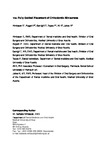Fully guided placement of orthodontic miniscrews-a technical report
| dc.contributor.author | Kirnbauer, B | |
| dc.contributor.author | Rugani, P | |
| dc.contributor.author | Santigli, E | |
| dc.contributor.author | Tepesch, P | |
| dc.contributor.author | Ali, Kamran | |
| dc.contributor.author | Jakse, N | |
| dc.date.accessioned | 2019-09-28T15:46:17Z | |
| dc.date.available | 2019-09-28T15:46:17Z | |
| dc.date.issued | 2019-06 | |
| dc.identifier.issn | 2207-7472 | |
| dc.identifier.issn | 2207-7480 | |
| dc.identifier.uri | http://hdl.handle.net/10026.1/14946 | |
| dc.description.abstract |
Introduction: Orthodontic miniscrews are used to obtain skeletal anchorage during orthodontic treatment and their application is growing due to the simple method of placement and removal, which invites improved patient compliance without significant impact on function and aesthetics. However, complications and risks are reported that underscore the need for a thorough preoperative assessment to enable accurate placement, especially in confined sites. A novel approach is presented which employs a custom-designed 3D-printed splint to facilitate a fully-guided placement of orthodontic miniscrews. Materials and methods: The presented splint was virtually planned using coDiagnostiX® software after matching the DICOM data and STL file, to enable fully-guided screw insertion. Insertion depth was defined by a sleeve tube height that provided a depth stop when contact was reached with the head of the hand piece. Additionally, to prevent movement of the insertion instrument, a custom metallic sleeve was designed and 3D-printed by a metallic printer. Results: Accurate placement was achieved and no complications were experienced during insertion and use. Conclusions: The insertion approach provides more predictable results and enables accurate placement of orthodontic screws. The procedure avoids associated risks and complications primarily encountered in difficult cases. | |
| dc.format.extent | 71-74 | |
| dc.language.iso | en | |
| dc.publisher | Australian Society of Orthodontists | |
| dc.title | Fully guided placement of orthodontic miniscrews-a technical report | |
| dc.type | journal-article | |
| dc.type | JOUR | |
| plymouth.author-url | https://www.webofscience.com/api/gateway?GWVersion=2&SrcApp=PARTNER_APP&SrcAuth=LinksAMR&KeyUT=WOS:000511253700011&DestLinkType=FullRecord&DestApp=ALL_WOS&UsrCustomerID=11bb513d99f797142bcfeffcc58ea008 | |
| plymouth.issue | 1 | |
| plymouth.volume | 35 | |
| plymouth.publisher-url | https://search.informit.com.au/documentSummary;dn=489605657597050;res=IELHEA | |
| plymouth.publication-status | Published | |
| plymouth.journal | Australasian Orthodontic Journal | |
| plymouth.organisational-group | /Plymouth | |
| plymouth.organisational-group | /Plymouth/Faculty of Health | |
| plymouth.organisational-group | /Plymouth/Users by role | |
| dcterms.dateAccepted | 2019-03-17 | |
| dc.rights.embargodate | 2020-5-29 | |
| dc.identifier.eissn | 2207-7480 | |
| dc.rights.embargoperiod | Not known | |
| rioxxterms.licenseref.uri | http://www.rioxx.net/licenses/all-rights-reserved | |
| rioxxterms.licenseref.startdate | 2019-06 | |
| rioxxterms.type | Journal Article/Review |


